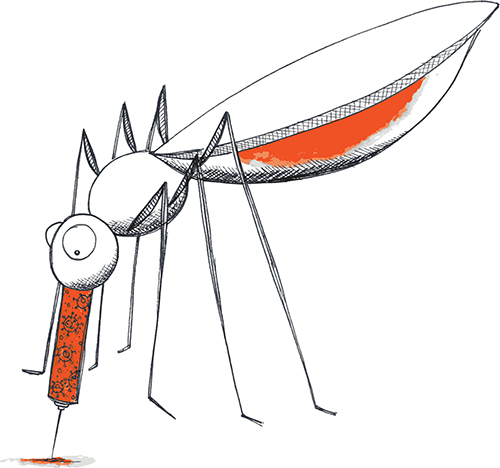Rare NEJM Case Study Raises Questions about Zika Transmission
The first Zika virus-related death in the continental U.S. occurred in June of this past year, but even now, months later, two aspects of this case continue to puzzle health experts. First, why did this patient die? It is quite rare for a Zika infection to cause severe illness in adults, much less death. Second, how did another individual, who visited the first while in the hospital, become ill from Zika? This second patient did not do anything that was known at the time to put people at risk for contracting the virus.

Researchers at ARUP Laboratories and the University of Utah School of Medicine in Salt Lake City begin to unravel the mystery in The New England Journal of Medicine. Details from the two cases point to an unusually high concentration of virus in the first patient’s blood as being responsible for his death. The phenomenon may also explain how the second patient may have contracted the virus through casual contact with the primary patient, the first such documented case.
Patient 1 was initially identified as being potentially infected with Zika virus during validation of a real- time PCR test for Zika virus, now offered by ARUP Laboratories (see sidebar), and was subsequently confirmed as positive by both the Utah Department of Health and the Centers for Disease Control and Prevention.
“From a clinical perspective, an important finding was that the virus can be transmitted person-to-person by routes other than mosquito bites or through sexual contact,” says coauthor Kimberly Hanson, MD, MHS, a medical director at ARUP. “This was the first recognized case, and a very rare one, of a secondary Zika virus infection acquired by contact with a sick person.”
This case emphasizes the need to further understand how Zika spreads and what precautions may need to be taken to prevent spreading. “We may never see another case like this one,” says corresponding author Sankar Swaminathan, MD, chief of Infectious Disease and professor of internal medicine at the University of Utah School of Medicine. “But one thing this case shows us is that we still have a lot to learn about Zika.”
"From a clinical perspective, an important finding was that the virus can be transmitted person-to-person by routes other than mosquito bites or through sexual contact, this was the first recognized case, and a very rare one, of a secondary Zika virus infection acquired by contact with a sick person.
Kimberly Hanson, MD, MHS, Medical Director, Mycology; Section Chief, Clinical Microbiology
The narrative unfolds in the NEJM case study. Last May, Patient 1 (a 73-year-old man) traveled to southwest Mexico, a Zika-endemic area. Eight days after returning, he started having abdominal pain and fever, and by the time he was admitted to the University of Utah hospital he also had inflamed, watery eyes, dangerously low blood pressure, and a rapid heart rate. Despite the medical staff’s best efforts to stabilize him, his condition declined rapidly. During this time, Patient 2 came to visit and reported wiping away Patient 1’s tears and helping to reposition him in the hospital bed. It wasn’t long before Patient 1 slipped into septic shock, and his kidneys, lungs, and other organs started to shut down. He died shortly thereafter.
Even though it’s well known that Zika can cause severe brain damage in unborn babies, symptoms are typically mild in adults. At the time of Patient 1’s death, only nine other Zika-related deaths have been reported worldwide, says Swaminathan. Despite the odds, tests performed after Patient 1’s death revealed that he had Zika.
Further research using Taxonomer, a tool developed by scientists at University of Utah and ARUP Laboratories that rapidly analyzes all genetic material from infectious agents in a patient’s sample, suggested that there were no other obvious infections in the blood that explained his illness. “There was a question of whether this may be a more pathogenic strain. The viral genome sequence didn’t support this, which put more weight on the high viral load,” explains ARUP Medical Director Robert Schlaberg, MD, MPH. Taxonomer also found that the Zika virus that infected the patient was 99.8 percent identical to that carried by a mosquito collected from southwest Mexico, the same region that Patient 1 had visited a few weeks prior.
Seven days after Patient 1’s death, Patient 2 developed red, watery eyes, a common Zika symptom. Tests suggested that Patient 2 had also developed a Zika infection, but in contrast to Patient 1, this patient only had mild symptoms that resolved within the following week.
Like Patient 1’s death, Patient 2’s diagnosis was unexpected. The species of mosquito that carries Zika had not been found in Utah, and Patient 2 had not traveled to a Zikaendemic area. A reconstruction of events ruled out other known means of catching the virus. An unprecedented transmission by casual contact between the two patients was found to be the most likely explanation.
“This and any future cases will force the medical community to critically re-evaluate established triage processes for determining which patients receive Zika testing and which do not,” says ARUP Medical Director Marc Couturier, PhD.

"This type of information could help us improve treatments for Zika as the virus continues to spread across the world and within our country.
Sankar Swaminathan, MD, Chief of Infectious Disease, Professor of Internal Medicine, University of Utah School of Medicine
The authors believe that the reason behind the unusual nature of the case lies in yet another anomaly. Patient 1’s blood had a very high concentration of virus, at 200 million particles per milliliter. This equals roughly 10 million viral particles per drop of blood. “I couldn’t believe it,” says Swaminathan.
“The viral load was 100,000 times higher than what had been reported in other Zika cases [at this point in time], and was an unusually high amount for any infection.” The observation opens up the possibility that the extraordinary amount of virus overwhelmed the patient’s system, making him extremely infectious.
Our test is reliable, robust, and reproducible to run— meaning that it produces the same results in multiple tries. We can also test more patients, more rapidly, with this test. A patient may get a faster result from us, and know sooner that they’re off the hook.
Marc Couturier, PhD, D(ABMM), Medical Director, Microbial Immunology, Parasitology and Fecal Testing, and Infectious Disease Rapid Testing
Still, what led to the unusually severe infection in the first place remains unknown. Was there something about Patient 1’s biology or health history that made him particularly susceptible? There were small differences in the virus’ genetic material compared to other samples of Zika virus; did they cause the virus to be exceptionally aggressive?
Swaminathan says, “This type of information could help us improve treatments for Zika as the virus continues to spread across the world and within our country.”

What’s Known Now About Zika? 10 Questions.
Can any mosquito carry Zika?
Zika virus is transmitted primarily through the bite of an infected Aedes species mosquito (Ae. Aegypti and Ae. Albopictus). These mosquitoes also spread dengue and chikungunya viruses.
What is the range of the transmitting mosquitoes?
In the United States, one or the other of these mosquito species can be found in Southern California and extending just north of San Francisco, across the Southern states, across the Midwest into southern Minnesota, and into New York, southern Connecticut, and sometimes into other New England states.
What is the best prevention for Zika?
Avoid mosquito bites, wear (male or female) condoms during sex to reduce the chance of contracting Zika. Should you look out for mosquitoes only during the day? Mosquitoes that spread Zika bite during the day and night.
What are Zika symptoms?
Fever, rash, joint pain, conjunctivitis, muscle pain, headache.
Are there always symptoms?
Many people infected with Zika won’t have symptoms or will have only mild symptoms.
When do symptoms show up?
Usually within a week, if symptoms occur. They usually last several days to a week.
What is the usual result of Zika?
People rarely die of Zika, and many people might not realize they have been infected. But if you think you may have had Zika, get a diagnosis and blood or urine test, treat symptoms, and protect others from being exposed. More information is available on the CDC website on preventing exposure.
Where in the world have Zika infections been identified?
Most of South America except for Chile and Uruguay, the Caribbean island nations, Central America and Mexico, Florida and Texas in the United States, and Africa’s Cape Verde Islands.
Once you have it, can you get it again?
Probably not. That is, once a person is infected, they are likely to be protected from future infections.

















 HOME
HOME